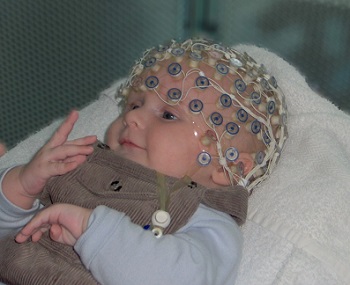One of the most incredible "miracles" of development remains the learning of language by a baby: how in barely three years, does he manage to master French while you still struggle with English despite many years of intensive lessons? In few months, essential steps are reached: understanding that speech transmits information, but also that this continuous acoustic signal is composed of elementary bricks that can be combined in multiple ways to create new messages. Despite the significant acoustic difference between his big sister's high-pitched voice and his dad's low-pitched voice, the baby must understand that they are both talking about him, the "baby", and not about " pépé". Yet the difference between "b" and "p" is minimal compared to the difference in voice, a problem that took engineers a long time to solve to enable voice recognition in your smartphone. They have solved it, but differently from the baby, by creating and analyzing huge databases, which is obviously not within the reach of the infant. So how does he do it ?
An effective solution to get rid of the "noise" in the signal, proposed in the field of visual perception, is to factorize this signal, by projecting it on a reduced set of orthogonal components. In this study, the researchers therefore asked whether a similar decomposition strategy was used for speech. Indeed, linguists describe each phoneme or sound, used in languages, as a series of binary distinctive features, for example b is occlusive, bilabial and sonorous, and is opposed to p also occlusive and bilabial but deaf whereas m is bilabial and sonorous but nasal, etc... Can this code, based on articulatory characteristics of how sound is produced, be used by infants too young even to babble?
Using a high-resolution (256-channel) electroencephalographic (EEG) system, researchers recorded the neural responses of 3-month-old infants to 120 natural Consonant-Vowel syllables presented in a pseudorandom order with varied acoustic and phonetic profiles for approximately 1 hour. Thanks to multivariate analyses, they show that indeed each phonetic feature is coded, then these features are combined to perceive the identity of the consonant and then the vowel, which remain clearly separated.

© UNICOG (NeuroSpin/CEA)
In conclusion, human infants are equipped with a structured combinatorial code for speech analysis, which could explain the rapid rate of language acquisition in the first year. The fast and stable analysis of the speech allows to discover the rules of combination of these elementary bricks to create words, words which are very quickly used as labels of categories of the environment.
Contact : ghislaine.dehaene-lambertz@cea.fr